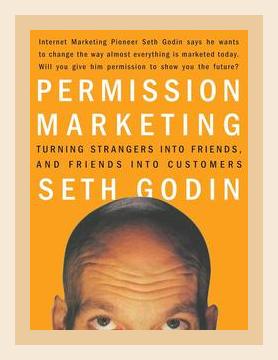Marketing and SalesAdvertising
Summary of Seth Godin’s Permission Marketing: Turning Strangers into Friends and Friends into Customers
1. Introduction to Permission Marketing
Seth Godin’s Permission Marketing challenges the traditional approach of “interruption marketing,” typified by untargeted and intrusive advertising messages that consumers often ignore. Instead, Godin advocates for a more respectful, engaging, and sustainable approach called “permission marketing.” This method focuses on obtaining a customer’s consent before sending them marketing messages, fostering a relationship built on trust and relevance.
Action: Begin by identifying your target audience and devising a clear strategy to obtain their permission to communicate. This can be through subscription lists, loyalty programs, or incentives that invite customers to opt-in willingly.
2. Techniques of Permission Marketing
Godin outlines four key techniques for effective permission marketing:
- Anticipated: The consumer is expecting the information.
- Personal: The marketing message is directly relevant to the consumer.
- Relevant: The message has intrinsic significance and value to the consumer.
Example: American Airlines’ AAdvantage program personalizes offers and deals based on the travel habits and preferences of each member.
Action: Use data analytics to personalize your messaging. Send offers specifically tailored to your customers’ past behaviors and preferences.
3. The Five Levels of Permission
Godin identifies five levels of permission which indicate varying degrees of consumer engagement and trust:
- Situation-specific Permission: One-time use, often transactional.
- Brand Trust: Consumer trusts the brand repeatedly.
- Personal Relationship: Direct, ongoing relationship possibly with a representative.
- Points for Permission: Customers provide permission in return for rewards.
- Intravenous: Seamless and continuous permission, deeply integrated into a customer’s life.
Example: Amazon’s ability to make personalized product recommendations and send targeted emails reflects a high level of permission.
Action: Ascend through these levels by starting with situation-specific engagement and gradually fostering deeper trust. Offer loyalty programs with points to encourage customer interaction and engagement.
4. Permission Marketing Campaign Structure
Godin emphasizes that effective permission marketing needs a strategic structure comprising multiple steps:
- Interruption: Initial contact using traditional marketing.
- Incentive: Providing value to gain permission.
- Learning: Gather information to better understand the consumer’s needs.
- Reinforcement: Follow up with relevant communications to deepen the relationship.
Example: Financial service companies employing webinars that offer valuable insights, thereby incentivizing customers to sign up and continue receiving communications.
Action: Design campaigns that start with an attention-grabbing hook followed by a strong value proposition, such as free resources or trials.
5. The Role of Frequency in Permission Marketing
According to Godin, frequency is vital in maintaining a permission-based relationship. Successful campaigns repeatedly engage their audience without overwhelming them.
Example: Newsletters that provide timely, useful information rather than constant sales pitches.
Action: Develop a content calendar to ensure regular, valuable communication with your customers, such as monthly newsletters or weekly updates.
6. Conversion of Strangers to Customers
Godin highlights the importance of transforming strangers into friends before they become customers. It’s about earning trust and reinforcing positive interactions.
Example: Nike’s email marketing campaigns that provide valuable fitness tips and personalized product recommendations.
Action: Create a nurturing sequence for new subscribers that starts with value-laden content, progressively moving towards more product-focused messaging.
7. Measuring Success: Metrics that Matter
In permission marketing, metrics go beyond open rates and conversions. They must consider the quality of engagement and overall customer lifetime value.
Example: A company’s use of customer satisfaction scores alongside typical marketing metrics to gauge the effectiveness of their campaigns.
Action: Integrate qualitative metrics such as customer feedback and net promoter scores into your analysis to get a comprehensive view of campaign performance.
8. Trust and Transparency
Transparency is crucial in permission marketing. Disclosing how customer data is used and ensuring it aligns with the consumer’s interests builds trust.
Example: Brands providing clear opt-in mechanisms and easy options for users to manage their communication preferences.
Action: Be transparent in your communication, provide clear privacy policies, and offer easy-to-use preference management tools.
9. The Importance of Consistency
Consistency in messaging and value delivery is key in making permission marketing effective.
Example: Regularly scheduled newsletters that always deliver high-quality content, such as The New York Times’ morning briefing.
Action: Develop a consistent schedule for communications. Ensure each message lives up to the promise of quality and relevance that your brand stands for.
10. Case Studies and Success Stories
Godin provides several case studies to illustrate successful permission marketing. For example, Yahoo! using games to engage users and incentivize them to provide their email addresses.
Example: A cosmetics company implementing a points system that rewards users for watching tutorials and sharing their experiences.
Action: Design caseable initiatives where the consumer actively participates in exchange for rewards or exclusive content, enhancing loyalty and permission levels.
11. Pitfalls to Avoid
Godin warns of potential pitfalls, such as over-communicating, irrelevant messaging, and unethical data use, which can erode trust.
Example: A brand losing subscribers due to excessive or irrelevant emails.
Action: Regularly audit your communication strategies to ensure they remain relevant and respectful of your customers’ level of permission.
12. The Future of Permission Marketing
Godin anticipates that permission marketing will become increasingly relevant as consumers gain more control over how they receive information.
Action: Stay adaptive and forward-thinking. Continuously evolve your strategies to keep up with changing consumer preferences and technological advancements.
Conclusion
Seth Godin’s Permission Marketing presents a paradigm shift in how businesses approach their customers, advocating for a more considerate, engaging, and ultimately effective means of marketing. By gaining permission and fostering trust, businesses can build loyal, long-term relationships with their customers. Following Godin’s advice can lead to more meaningful interactions, elevated customer satisfaction, and sustainable business growth.
Final Action: Implement the principles outlined in the book step-by-step, continuously evaluate your methods, and adapt as necessary to ensure the development of a strong, permission-based relationship with your customers.
